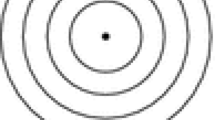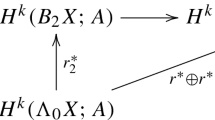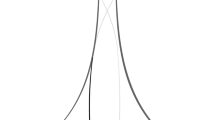Abstract
We show that the shortest closed geodesic on a 2-sphere with non-negative curvature has length bounded above by three times the diameter. We prove a new isoperimetric inequality for 2-spheres with pinched curvature; this allows us to improve our bound on the length of the shortest closed geodesic in the pinched curvature setting.

Similar content being viewed by others
References
Abbondandolo, A., Bramham, B., Hryniewicz, U., Salomão, P.: A systolic inequality for geodesic flows on the two-sphere. Math. Ann. 367, 701–753 (2017)
Andrews, B., Clutterbuck, J.: Sharp modulus of continuity for parabolic equations on manifolds and lower bounds for the first eigenvalue. Anal. PDE 6(5), 1013–1024 (2013)
Balacheff, F., Croke, C., Katz, M.: A Zoll counterexample to a geodesic length conjecture. Geom. Funct. Anal. 19(1), 1–10 (2009)
Calabi, E., Cao, J.: Simply closed geodesics on convex surfaces. J. Differ. Geom. 36, 517–549 (1992)
Croke, C.: Area and the length of the shortest closed geodesic. J. Differ. Geom. 27(1), 1–21 (1988)
Cheng, S.Y.: Eigenvalue comparison theorems and its geometric applications. Math. Z. 143(3), 289–297 (1975)
Green, L.: Auf Wiedersehensflächen. Ann. Math. 78(2), 289–299 (1963)
Gromov, M.: Filling Riemannian manifolds. J. Differ. Geom. 27, 1–147 (1983)
Hass, J., Morgan, F.: Geodesic nets on the 2-sphere. Proc. Am. Math. Soc. 124(12), 3843–3850 (1996)
He, Y.: A lower bound for the first eigenvalue in the Laplacian operator on compact Riemannian manifolds. J. Geom. Phys. 71, 73–84 (2013)
Hersch, J.: Quatre propriétés isopérimétriques de membranes sphériques homogènes (French). C. R. Acad. Sci. Paris Sér. A-B 2, 270 (1970)
Lichnerowicz, A. Géométrie des groupes de transformations (French). Travaux et Recherches Mathématiques, III. Dunod, Paris ix+193 (1958)
Hutchings, M., Morgan, F., Ritoré, M., Ros, A.: Proof of the Double Bubble Conjecture. Ann. Math. 155, 459–489 (2002)
Jost, J.: Riemannian Geometry and Geometric Analysis, 7th edn. Universitext Springer, Berlin (2017)
Maeda, M.: The length of a closed geodesic on a compact surface. Kyushu J. Math. 48(1), 9–18 (1994)
Morgan, F., Wichiramala, W.: The standard double bubble is the unique stable double bubble in \(R^2\). Proc. AMS 130, 2745–2751 (2002)
Nabutovsky, A., Rotman, R.: The length of the shortest closed geodesic on a two-dimensional sphere. Int. Math. Res. Not. 23, 1211–1222 (2002)
Nabutovsky, A., Rotman, R.: The minimal length of a closed geodesic net on a Riemannian manifold with a nontrivial second homology group. Geom. Dedicata 113, 243–254 (2005)
Rotman, R.: Flowers on Riemannian manifolds. Math. Zeit. 269, 543–554 (2011)
Rotman, R. Periodic geodesics and geodesic nets on Riemannian manifolds. Lecture, Institute for Advanced Study, March 5, 2019. https://video.ias.edu/ws/2019/0305-ReginaRotman (2019)
Rotman, R.: The length of a shortest closed geodesic on a two-dimensional sphere and coverings by metric balls. Geom. Dedicata 10, 143–157 (2005)
Rotman, R.: The length of a shortest geodesic net on a closed Riemannian manifold. Topology 46, 343–356 (2007)
Sabourau, S.: Filling radius and short closed geodesics of the sphere. Bull. Soc. Math. France 132(1), 105–136 (2004)
Sabourau, S.: Local extremality of the Calabi–Croke sphere for the length of the shortest closed geodesic. J. Lond. Math. Soc. 82(3), 549–562 (2010)
Yang, P., Yau, S.-T.: Eigenvalues of the Laplacian of compact Riemann surfaces and minimal submanifolds. Ann. Scuola Norm. Sup. Pisa Cl. Sci. (4) 7(1), 55–63 (1980)
Zhong, J.-Q., Yang, H.-C.: On the estimate of the first eigenvalue of a compact Riemannian manifold. Sci. Sin. Ser. A 27, 1265–1273 (1984)
Acknowledgements
The authors would like to recognize Christina Sormani and her NSF Grant DMS-1612049. The Grant made possible a conference at Yale where the authors learned of many of the results cited in this paper and had productive conversations with Alexander Nabutovsky, Regina Rotman, and Frank Morgan. The authors would also like to thank Stéphane Sabourau for helpful suggestions, as well as Ben Andrews for his helpful advice on how to linearly approximate eigenvalues of the related SLP. We also acknowledge Wolfgang Ziller for helpful discussions about short closed geodesics in the pinched curvature setting, the fruits of which will appear in a forthcoming paper. Finally, we want to acknowledge the generous contribution of the referee who indicated how our proof of the inequality \(L(S^2,g) \le 3D(S^2,g)\) could be extended to the sharp bound \(L(S^2,g) \le 3R(S^2,g)\).
Author information
Authors and Affiliations
Corresponding author
Additional information
Publisher's Note
Springer Nature remains neutral with regard to jurisdictional claims in published maps and institutional affiliations.
Appendix
Appendix
Using more advanced techniques from Sturm–Liouville theory we can improve the isoperimetric inequality in Theorem 4.1 when the sphere is not round. This improved version of the inequality is not needed for the proof of Theorem 1.2 that was presented in Sect. 4.
Theorem 5.1
Let \((S^2,g)\) be a \(\delta \)-pinched metric and denote by \(\eta =D\sqrt{K_{min}}\). Then
First note that \(2- \sin (\eta /2) \ge 1\) so that this isoperimetric inequality is indeed an improvement on that of Theorem 4.1. Moreover, because \(2- \sin (\eta /2) > 1\) when \(\eta \ne \pi \) we note that Theorem 5.1 together with Cheng’s [6] rigidity result when \(D=\pi /\sqrt{K_{min}}\) provide an alternate proof of the equality case of Theorem 1.2 that does not depend on the Blaschke ideas from Sect. 4.
This new inequality follows as before by combining the inequality due to Hirsch with an improved lower bound on the first eigenvalue. We therefore set out to calculate the linear approximation of \(\lambda _1(d,1)\) at \(d=\pi \). The main idea is that because the coefficients of the SLP are constant while the domain varies, we can restrict and extend eigenfunctions to compare the values \(\lambda _1(d,1)\) as \(d\rightarrow \pi \). Let us then define by \(\mu (d)\) the SLP eigenvalue \(\lambda _1(d,1)\). We then have
Lemma 5.2
For \(\pi \ge d >0\)
Proof
Define the change of variable \(\tanh (u)=\sin (x)\) on the SLP, helpfully suggested to us by Ben Andrews. This becomes
In particular, for \(d=1, T=+\infty \), the eigenvalue \(\mu =2\) is realized by \(y_{+\infty }=\tanh (u)\).
Recall that the first eigenvalue for a SLP can be written as a Rayleigh quotient
where
Denote by \(\hat{y}_T\) the eigenfunction of the SLP (3) normalized so \(\int _{-T}^T \hat{y}_T^2{{\,\mathrm{sech}\,}}^2(u)du=1\). Extended \(\hat{y}_T\) as a constant to the entire real line so (while keeping the same notation):
In order to use \(\mu (1)\le R[\hat{y}_T,+\infty ]\) we will need to bound \(\hat{y}_T(\pm T)\). Observe first that given the symmetries of the SLP (3) the function \(\hat{y}_T\) is an odd function. Since \(\mu (d)\) is the first eigenvalue, we know that \(\hat{y}'_T\) does not vanish in the open interval \((-T,T)\). Hence \(|\hat{y}_T(\pm T)| = \max _{-T\le u \le T} |\hat{y}_T(u)|\), so then
Replacing now \(R[\hat{y}_T,+\infty ]\)
Hence we obtain
Replacing now \(\tanh (T)=\sin (d/2)\) and using the Taylor series of sine at \(\pi /2\) we finally get
\(\square \)
We are now ready to prove Theorem 5.1.
Proof
The proof proceeds exactly as the proof for Theorem 4.1 and we begin by rescaling the metric so that \(K_{min}=1\) and by Myers theorem \(\eta = D \le \pi \). Lemma 5.2 then gives the bound \( 2 + 2(1-\sin (d/2)) \le \mu (d) = \lambda _1(d,1)\). Following the ideas of [4] we combine this lower bound on \(\lambda _1\) with the upper bound due to Hirsch \(\lambda _1 \le \frac{8\pi }{A}\) (see [11, 25]) to yield
which we can manipulate to
Klingenberg’s injectivity radius estimate for positive metrics on 2-spheres says that
We have therefore related both area and diameter to \(\pi \), and conclude that
\(\square \)
Finally, while not necessary for the proof of Theorem 5.1, the following Lemma of independent interest expands the approach of Lemma 5.2 and gives an idea of the sharpness of its inequality, both in general and at the limiting case of \(d=\pi \).
Lemma 5.3
For \(\pi \ge d \ge 2\arcsin (\tanh (3/2)) \approx 2.263\)
where
Moreover, at the limiting case \(d=\pi \) we have \(\mu '(\pi )=0\) and \(\frac{1}{4}\le \mu ''(\pi )\le \frac{3}{2}\).
Proof
Define the test function \(y_T = \tanh (u) - u{{\,\mathrm{sech}\,}}^2(T)\), which by design satisfies the Neumann initial conditions of (3). By direct calculation
Hence our test function \(y_T\) gives us the inequality
where the last inequality is valid if \(T\ge \frac{3}{2}\), so for \(d\ge 2\arcsin (\tanh (3/2))\approx 2.263\).
Using that \({{\,\mathrm{sech}\,}}^2(T)=1-\tanh ^2(T) = 1-\sin ^2(d/2)=\cos ^2(d/2)\) we have the desired inequality:
Turning our attention to the limiting case of \(d=\pi \), we Taylor expand cosine at \(\pi /2\) to yield
Similarly, we combine Lemma 5.2 and the Taylor expansion of sine at \(\pi /2\) to yield
From this pair of Taylor expansions we calculate that
\(\square \)
Rights and permissions
About this article
Cite this article
Adelstein, I., Vargas Pallete, F. The length of the shortest closed geodesic on positively curved 2-spheres. Math. Z. 300, 2519–2531 (2022). https://doi.org/10.1007/s00209-021-02875-8
Received:
Accepted:
Published:
Issue Date:
DOI: https://doi.org/10.1007/s00209-021-02875-8




